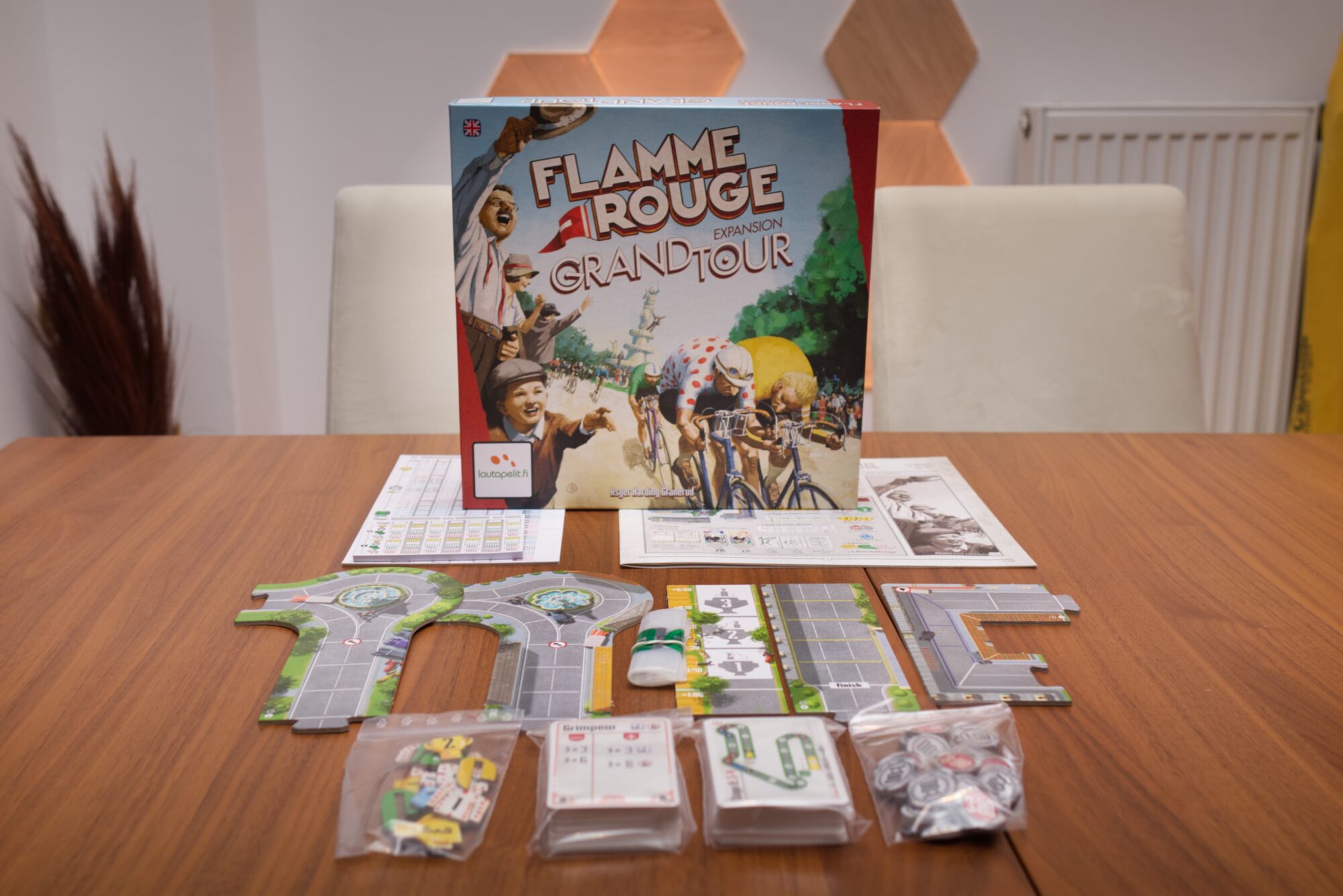After much waiting and a couple of false news alerts, the latest expansion for bike racing game Flamme Rouge is finally really here: Grand Tour is available for purchase. For some unknown reason, this expansion has been multiple years in the making – or rather waiting as there were multiple times where it looked like this was about to come out. But now in 2024, six years after the last expansion and 8 years after the original release of Flamme Rouge, it finally hits retail and the big question is: worth the wait or too little too late?
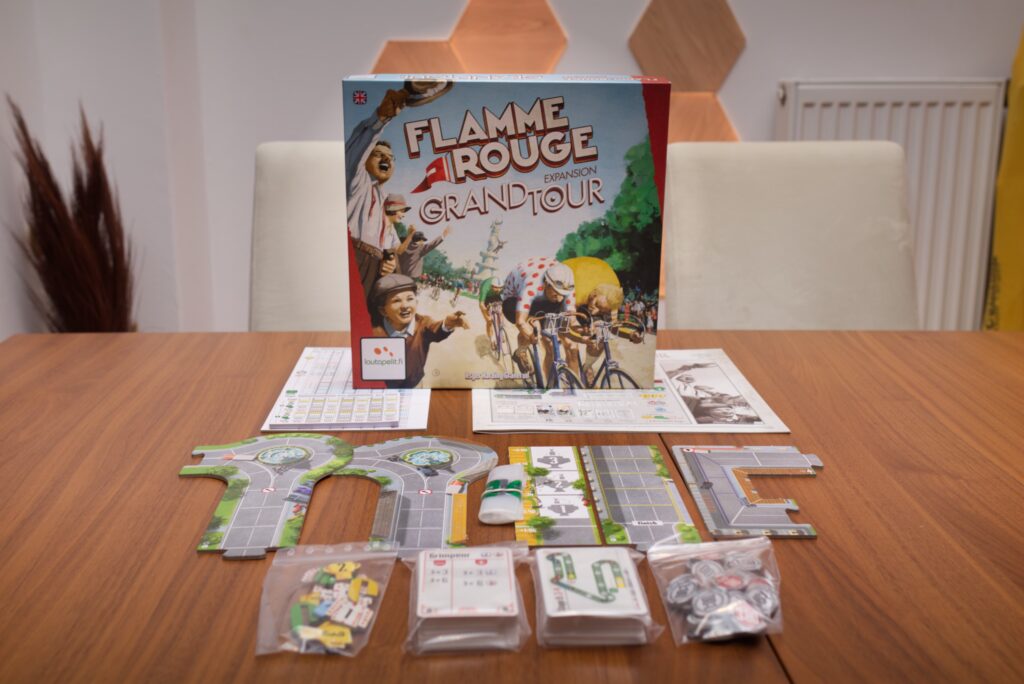
Where We Left Off …
When Flamme Rouge was originally released in 2016, racing games weren’t a category I was particularly interested in. Except for the chaotic card-programming craze of Robo Rally – which is much more akin to a hack-and-slash than a race if we’re honest – there wasn’t any racing game at all that had managed to keep my interest for more than a fleeting moment. Flamme Rouge though was different: easy rules, clever tactics, charming art style, a puzzle-piece configurable race track for replayability, and most of all it captured the essence of any bike race: using and preserving your energy.
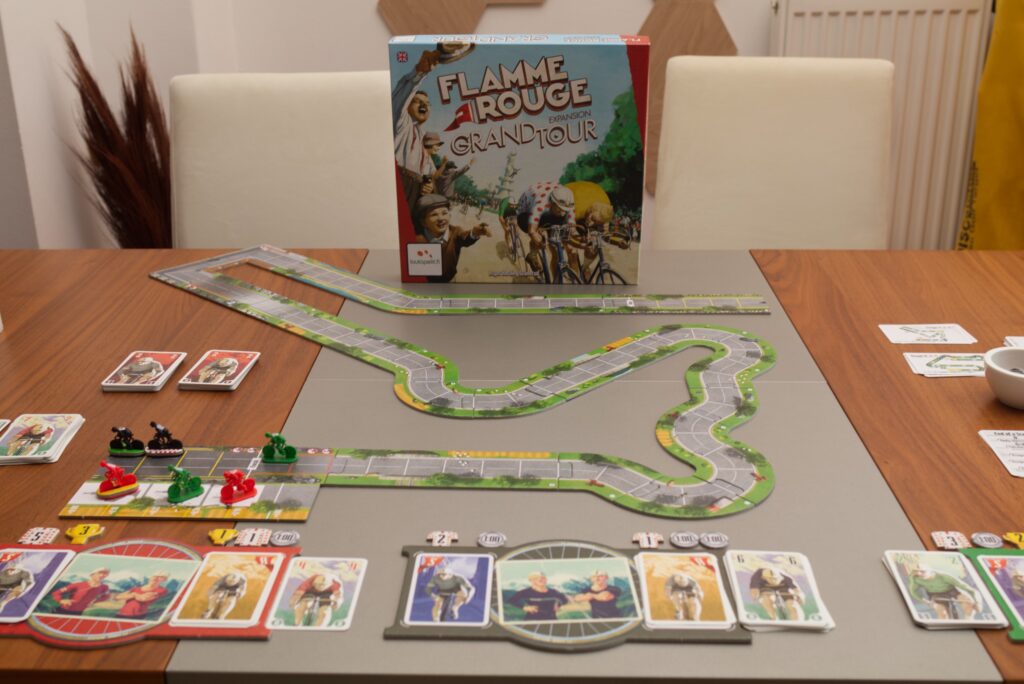
Each player controlled two cyclists, a consistent-speed, dependable Rouleur and a Sprinteur that would sometimes shoot away in giant bursts to then slow down to a crawl of exhaustion. Each cyclist starts with a fixed deck of numbered cards that is never replenished showing movement points in the range of 2 to 9. On a given turn, the players select which of their cyclists they want to plan for first. They then draw four cards from that deck, lock in one card and put the rest under the deck. Repeat for the other cyclist and that’s it. That’s all the agency one has and the rest is updating how the field of cyclists moves. Once used, a card is removed from game and thus the deck gets thinner and thinner during the course of the race.
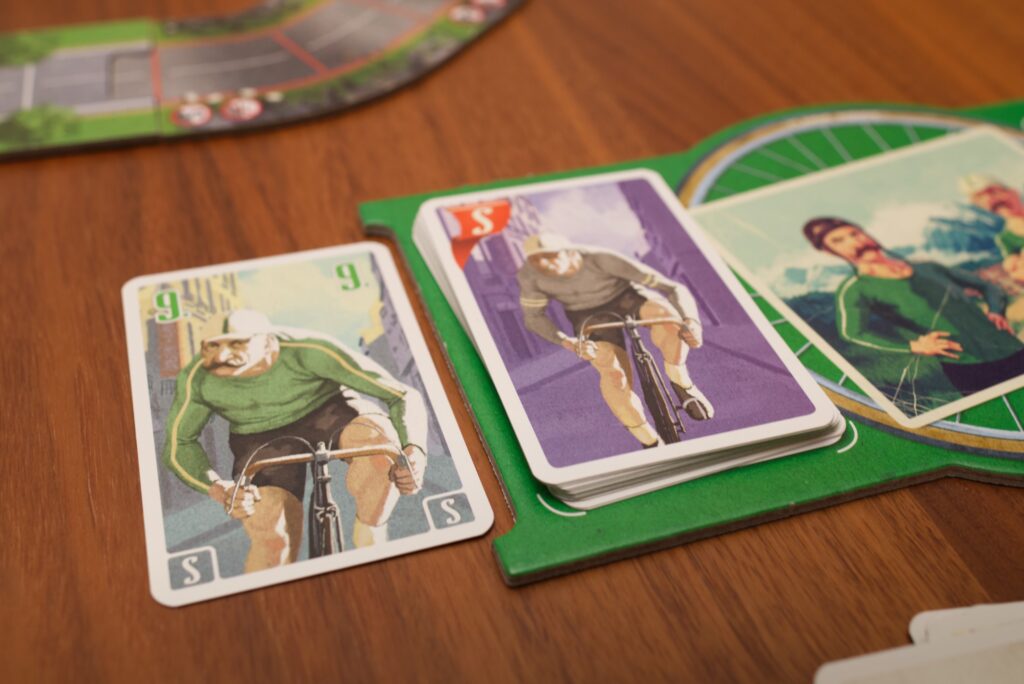
There are multiple elements that make this simple decision of which card to pick quite challenging: ascents that reduce the actual movement points shown on the card down to 5, descents that automatically raise any low value into a 5, slipstreaming that provides free movement points when ending a move close to other cyclist, extra exhaustion if a cyclist is in front and has no one in front to break the wind, and if nothing else there are always competing cyclists that might clog up the street in front of you. It’s both a strategic game of when in the race to use the high value cards and break free from the group but also tactical in figuring out what’s likely the best thing to do in any given situation. All of this made Flamme Rouge the only racing game that actually managed to eek into the BGG Top 200 at some point as far as I know.
Over the years, two expansions were released: Peloton (which mainly introduced automa and single-file cobblestone race tracks) and Meteo (which added weather modifiers and crashes). For me, Peloton was a must buy for both of the named aspects where Meteo is more a nice to have.
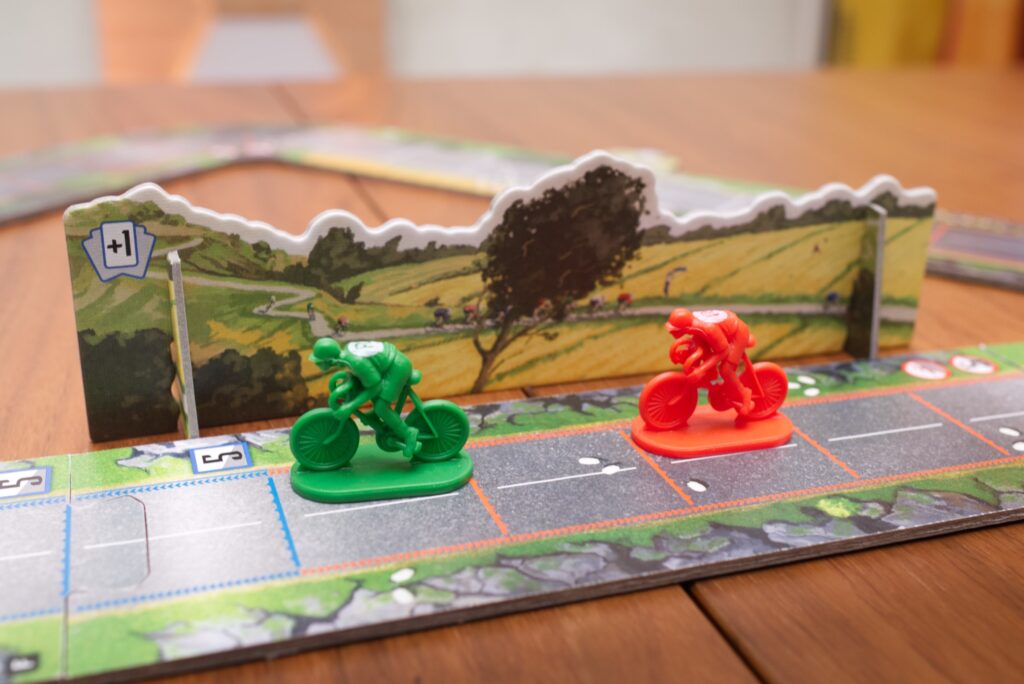
Tour Mode
Grand Tour now again adds multiple aspects to the base system and requires neither expansion but can be combined with them. The stand out feature is the tour mode which allows players to combine multiple races/tracks into one campaign. There is a whole set (21) of pre-made race track suggestions in the box and the rules recommend a 7 track tour to start with. The core idea is that points are awarded for the best climber, finish times are accumulated for each cyclist over all tracks, and so on. This is implemented by two scoring sheet blogs, one for each player and one for the overall tour. A new timing tile is placed next to the finish tile and when the first cyclist crosses the line, all cyclists that crossed the line in the same round measure their time based on the distance to the far edge of the tile. Every cyclist that didn’t make it gets a +1:00 tile and plays another round. This is continued until all cyclist are over the line and thus every single cyclist has a personal finishing time. On all subsequent races, those numbers are simply added for a total time for the whole tour.
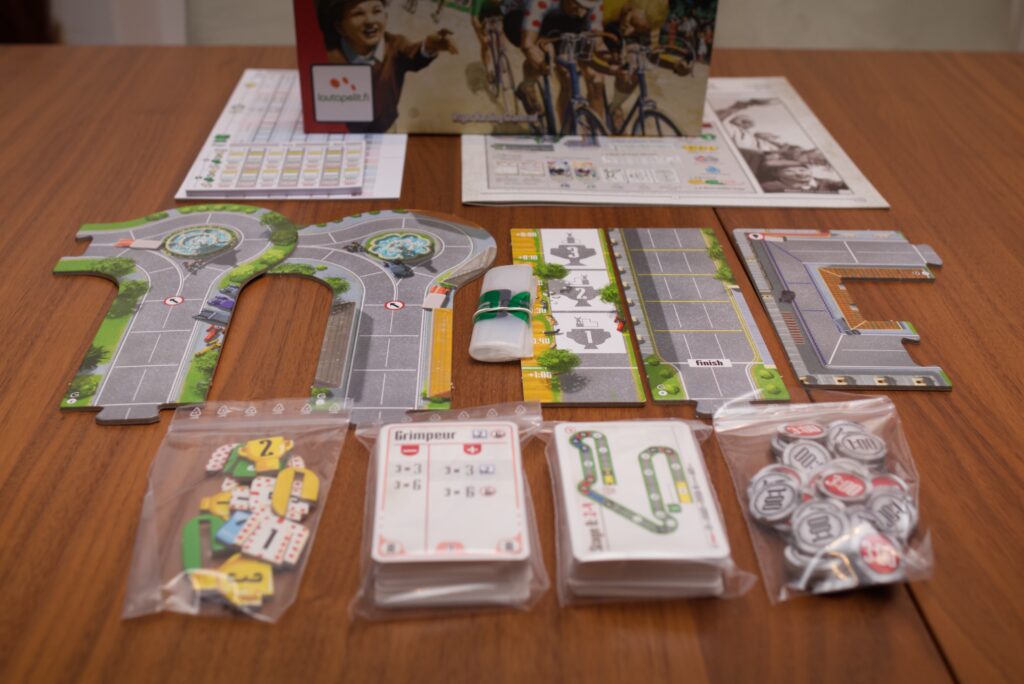
There are tiny cardboard trophies for the first three cyclists to finish (also recorded on the scoring sheets) and tiny jerseys that are positioned on the race track. E.g. the first cyclist to reach a certain spot in the race gains the highest value dotted jersey and thus collects points for best climber. There are also U-shaped cardboard tiles that can be slotted on top of the base of the cyclist mini to mark which specific figure is currently holding one title or the other.
The most interesting part though is that only half of the exhaustion cards still in a cyclist’s deck are removed at the end of a track! So if a sprinter for example does a particularly daring manoeuvre to win a track and collects a lot of exhaustion as part of the process, this will haunt them on the next track. I found this simple mechanism to work remarkably well. When playing Flamme Rouge solo, the general recommendation in the Peloton expansion is to start the race with 3 exhaustion cards added to each deck. When I played in a normal, reasonable style, I would usually end a race with 6 or 7 exhaustion and removing half would put me basically back to where I started. If I would make some tactical mistakes, I would end up with more exhaustion for the next race and if I played conservatively, I would end up with less. For longer campaigns, the rules add so called rest days to remove even more exhaustion. It’s a neat system.
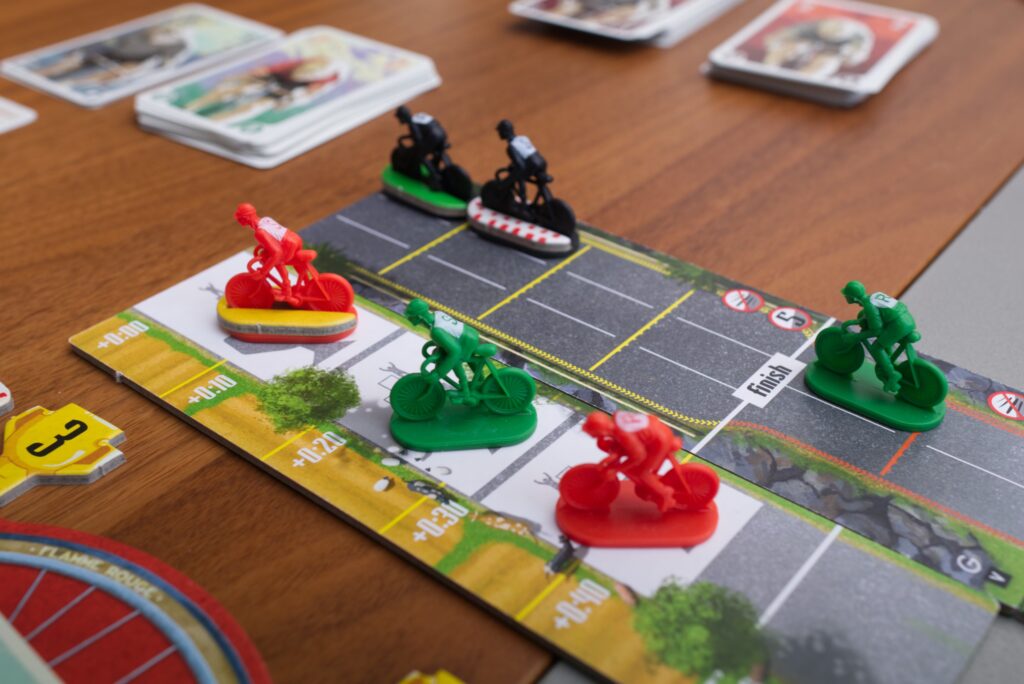
New Track Tiles
Besides a three-lane finish tile, there are only three new track tiles. Two are roundabouts where the outer line requires additional movement points and one is a sharp corner that contracts to a single lane. It features a crashing mechanism that is similar to the rainy surfaces in the Meteo expansion. If a cyclist can’t move their whole movement points because the road is blocked, they crash. In the heat of all players trying to pass this, chaos can easily ensue.
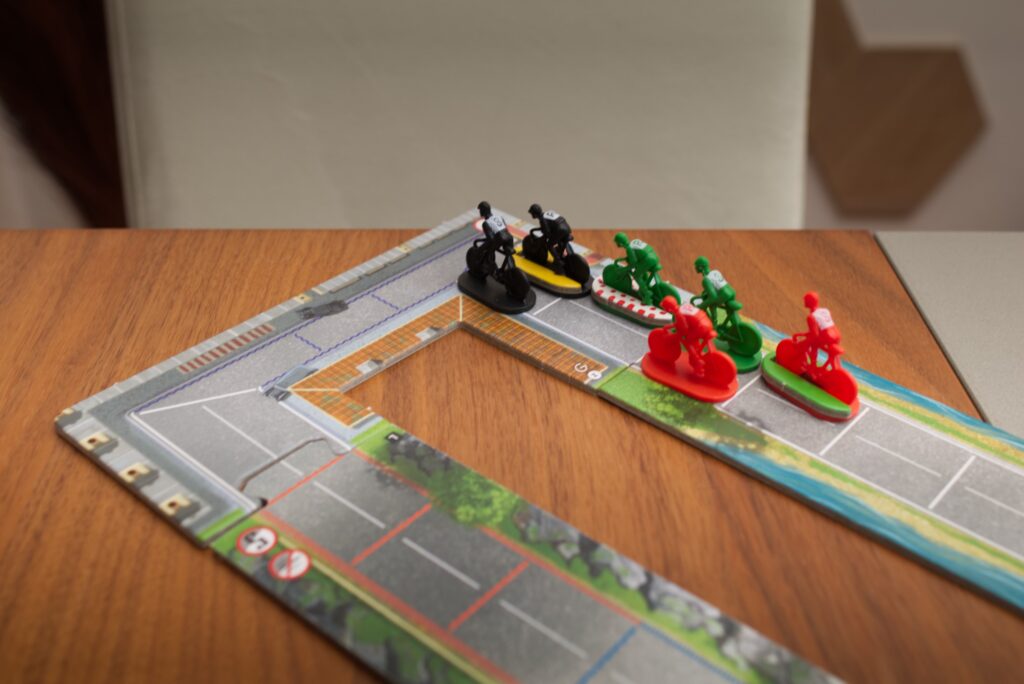
Specialists
The last element of the expansion are the specialists, sets of cards that modify the standard distribution of the Sprinteur / Rouleur decks or add special abilities. There is quite a number of them in the expansion, each of them unique and giving players options to race with their very own, unique raster of cyclists.
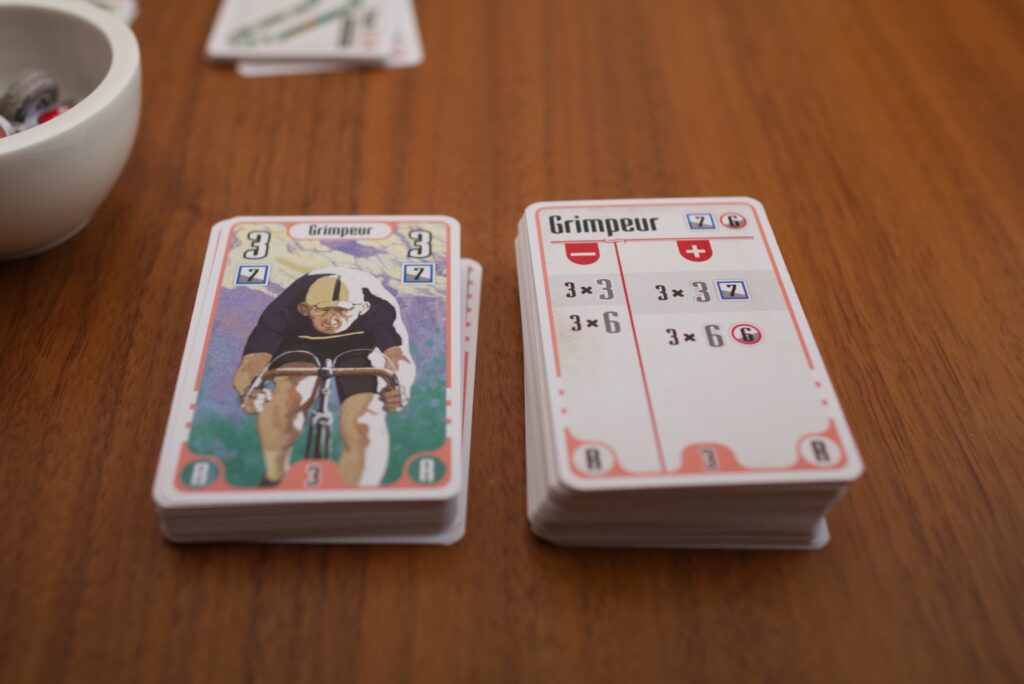
Conclusion
As I began to play Grand Tour, two strong impressions surfaced almost immediately: one, what a great expansion this is for Flamme Rouge fans, and two, that I’m no longer one of them. I have always enjoyed Flamme Rouge, both solo and multiplayer, because it’s a fun game and great system. Construct a new course, create the starting grid, and off you go into yet another fun race. The barrier of entry to Flamme Rouge is astonishingly low but there is a surprising amount of skill in playing it right. And as a hobby cyclists myself, I found this idea of representing the limited energy a cyclist has via a deck that never replenishes to be brilliant.
If Flamme Rouge: Grand Tour would have been published 2-3 years earlier, I would have played it to death! Sure, I would have liked a few more new track tiles because one can never have enough of those. But simply having the campaign mode and unique cyclists would have been enough to keep me interested. By now though, I enjoy Heat: Pedal to the Metal way more. No need to construct a track first, just pick a board. The challenge of when to risk using Heat is more engaging than when to spent a big movement card in Flamme Rouge. The automa in Heat are more dynamic than the automa in Flamme Rouge. The drafting of car upgrades, the weather system, the …
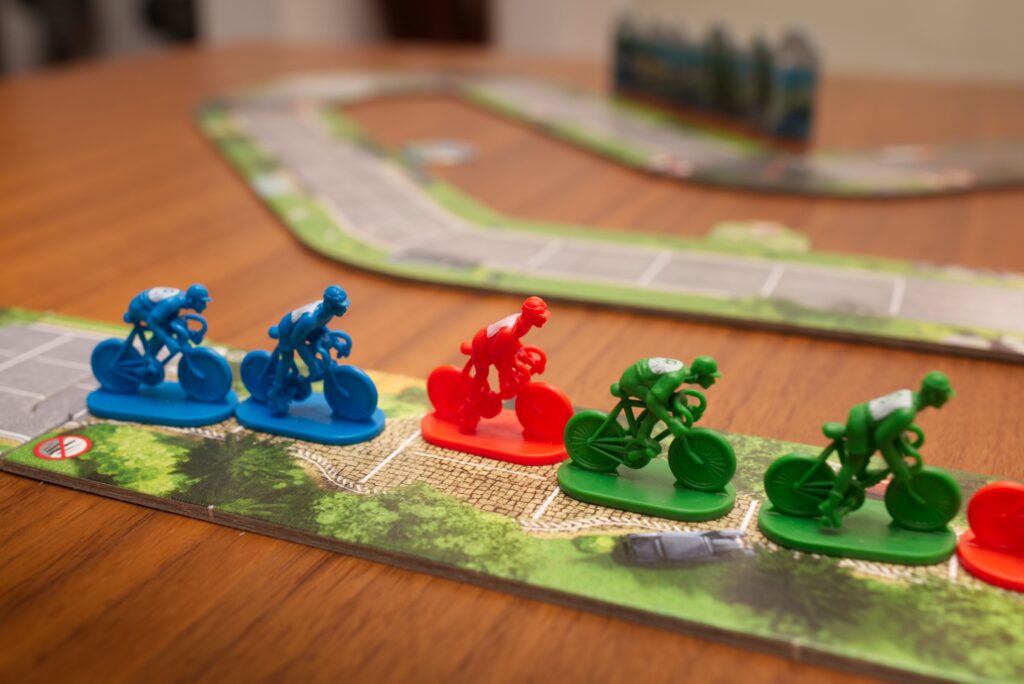
Playing Flamme Rouge and playing Heat is a very different experience: Flamme Rouge is more controlled and strategic where Heat is more crazy and tactical. I play two turns of Heat and my blood pressure goes up with excitement, I play two rounds of Flamme Rouge and I’m dispassionately thinking how well this system works and what the probabilities of me being able to slipstream are if I move a certain amount of points. As a result, there are those that will like Heat better and those that will like Flamme Rouge better. But I think there are few that will want or need both in their collection. And in that particular race, Heat is the clear winner for me.
So this is a happy and sad swan song for me and Flamme Rouge. It’s a great expansion for a very reasonable 35€, but it is also where our paths diverge. I’ve enjoyed my plays of Grand Tour but decided to sell my whole set of Flamme Rouge. All the expansions, all the promos I collected over the years. That is the sad part. The happy part though is that I know that fans of Flamme Rouge will get lots of fun out of this expansion. Having a new expansion at all after such a long time is something to rejoice. I’m just not sure if the long time it took publisher Lautapelit to release it is a sign that Flamme Rouge has a very low priority for them or a sign that they are back and there will be more Flamme Rouge from now on again. We’ll see …
If you’re new to Flamme Rouge, definitely give it a try. It’s a great game and easier to teach than Heat. My recommendation would be to buy base game plus Peloton to have the automa and more track tiles. If you like it, continue with Grand Tour and you will have fun for a long time. Meteo I would only recommend to completionists. It’s good, but doesn’t feel like it adds much to the formula. As for me, I’ll be eagerly awaiting the next expansion of Heat: Pedal to the Metal!
